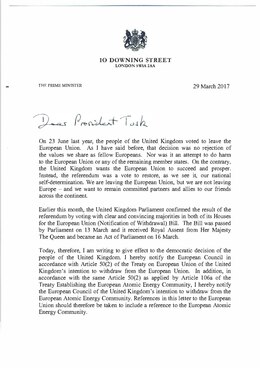
Back Invocación del artículo 50 del tratado de la Unión Europea por el Reino Unido Spanish Pemberlakuan Pasal 50 Perjanjian Uni Eropa oleh Britania Raya ID Permohonan United Kingdom untuk Artikel 50 Perjanjian Kesatuan Eropah Malay การใช้ข้อ 50 แห่งสนธิสัญญาว่าด้วยสหภาพยุโรปของสหราชอาณาจักร Thai Vương quốc Anh khởi động tiến trình tách ra khỏi Liên hiệp châu Âu Vietnamese
| Part of a series of articles on |
| Brexit |
|---|
 |
|
Withdrawal of the United Kingdom from the European Union Glossary of terms |
| Part of a series of articles on |
| UK membership of the European Union (1973–2020) |
|---|
 |

On 29 March 2017, the United Kingdom (UK) invoked Article 50 of the Treaty on European Union (TEU) which began the member state's withdrawal, commonly known as Brexit, from the European Union (EU). In compliance with the TEU, the UK gave formal notice to the European Council of its intention to withdraw from the EU to allow withdrawal negotiations to begin.
The process of leaving the EU was initiated by a referendum held in June 2016 which resulted in 52% voting in favour of British withdrawal. In October 2016, the British prime minister, Theresa May, announced that Article 50 would be invoked by "the first quarter of 2017".[1] On 24 January 2017 the Supreme Court ruled in the Miller case that the process could not be initiated without an authorising Act of Parliament, and unanimously ruled against the Scottish Government's claim in respect of devolution. Consequently, the European Union (Notification of Withdrawal) Act 2017 empowering the prime minister to invoke Article 50 was enacted in March 2017.
Invocation of Article 50 occurred on 29 March 2017, when Tim Barrow, the Permanent Representative of the United Kingdom to the European Union, formally delivered by hand a letter signed by the prime minister to Donald Tusk, the president of the European Council in Brussels.[2] The letter also contained the United Kingdom's intention to withdraw from the European Atomic Energy Community (EAEC or Euratom). This means that the UK was scheduled to cease being a member of the EU at the end of 29 March 2019 Brussels time (UTC+1), which would be 23:00 on 29 March British time.[3][4] This was extended by two weeks to give the Parliament of the United Kingdom time to reconsider its rejection of the agreement on withdrawal conditions, particularly in the House of Commons. The UK was due to leave the EU at the end of 12 April 2019 (24:00 Central European summer time; 23:00 British summer time), however a further "flexible" extension was granted until 31 October 2019 after talks at the European Council meeting on 10 April.[5] After another extension in October 2019 and subsequent negotiations, a withdrawal agreement was negotiated in late October 2019 and ratified by both parties in January 2020: consequently the UK left the EU at 23:00 on 31 January 2020 and entered the transition period.
- ^ "Brexit: Theresa May to trigger Article 50 by end of March". BBC News. 2 October 2016. Archived from the original on 12 April 2019. Retrieved 16 October 2016.
- ^ Cite error: The named reference
NYT a50 letter deliveredwas invoked but never defined (see the help page). - ^ Bloom, Dan (29 March 2017). "Brexit Day recap: Article 50 officially triggered on historic day as Theresa May warns: 'No turning back'". Daily Mirror. Archived from the original on 29 March 2017. Retrieved 29 March 2017.
- ^ "House of Commons Briefing Paper 7960, summary". House of Commons. 6 February 2019. Archived from the original on 16 February 2019. Retrieved 16 February 2019.
- ^ "Special European Council (Art.50), 10/04/2019 – Consilium". www.consilium.europa.eu. Archived from the original on 31 March 2019. Retrieved 13 April 2019.
© MMXXIII Rich X Search. We shall prevail. All rights reserved. Rich X Search
